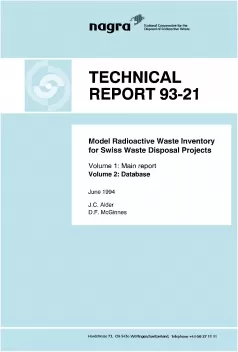
Technical Report NTB 93-21
Model Radioactive Waste Inventory for Swiss Waste Disposal Projects
A model radioactive waste inventory (MIRA) has been developed for Swiss waste disposal projects (repository planning, safety assessment).
The model inventory describes the conditioned and packaged wastes that are expected to be produced by the 5 operational Swiss NPP's (3GW(e) over 40 years, with the last NPP assumed to be shut-down in 2024). The waste categories assumed are: operational waste, exchangeable non-fuel reactor core components, decommissioning waste and reprocessing waste (with the assumption of complete reprocessing of spent fuel). The model inventory also details the wastes arising from medicine, industry and research between 1984 (previous waste arisings were sea-dumped) and 2053. The decommissioning wastes of the PSI 600 MeV proton (1.5 mA) accelerator facility, assumed to be shut-down in 2034, are also included.
The waste arisings are described by 80 waste sorts each defined using an average waste package description linked to the number of packages arising with time. Radionuclide activities (overall 117 nuclides with t1/2 > 60 days), other radiological characteristics, material content, specific properties (such as surface to mass ratios for metals), package internal drawing and predicted maximal values of the package are provided in a database of the waste sorts given in Volume 2. This data is presented and discussed in Volume 1, along with a short description of the origin of the raw waste.
Within Volume 1 a provisional allocation of the waste sorts to the 2 repository types "SMA" and "LMA/HAA" has been made. This results in 3 waste sort classifications: SMA (short-lived LLW + ILW), LMA (long-lived ILW) and HAA (HLW). The summation of the waste volumes, activities, radiotoxicities and materials gives an overview of the repository waste contents. Uncertainties associated with the repository inventories data have been analysed. The results provide an indication of the waste volume reserves to be considered for the repositories and of the relative accuracy of the activities for the safety analyses.
